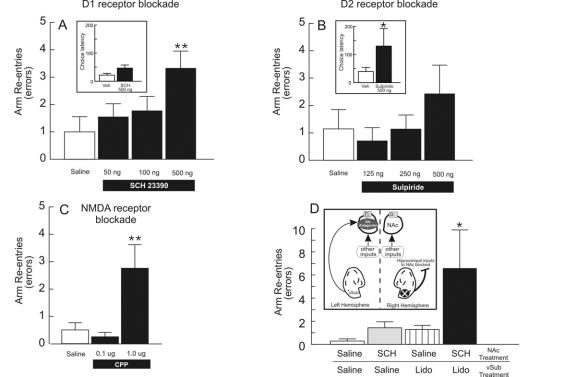Fig. 5: D1 and N-methyl-D-aspartate (NMDA) receptor activity in the nucleus accumbens (NAc) mediate exploratory foraging behaviour dependent on hippocampal–ventral striatal circuitry. Panels A, B and D adapted from Floresco and Phillips.74 (A) Intra-NAc infusion of the D1 antagonist R-(+)-8-chloro-2,3,4,5-tetrahydro-3-methyl-5-phenyl-1H-3-benzazepine-7-ol (SCH 23390) disrupts the efficient search for food during a “random foraging” task on a radial arm maze but does not exert as pronounced an effect on choice latency (inset). (B) Blockade of D2 receptors in the NAc with sulpiride does not affect the accuracy of search behaviour but induces a dramatic increase in choice latency (inset). (C) NMDA receptor blockade in the NAc with 3-(2-carboxypiperazine-4-yl)propyl-1-phosphate (CPP) also impaired search behaviour in a manner similar to D1 receptor antagonism. (D) D1 receptors serve to selectivity modulate hippocampal inputs to the NAc during exploratory foraging. Neither unilateral inactivation of the ventral subiculum (vSub) by lidocaine (Lido, striped bar) infusions nor unilateral D1 receptor blockade in the NAc (SCH, grey bar) disrupted search behaviour. However, simultaneous administration of both of these asymmetric manipulations caused a substantial disruption in efficient search, wherein rats were more likely to re-enter arms visited previously during the trial. The inset diagrams the asymmetric infusion procedure used in this experiment, consisting of a unilateral infusion of a D1 receptor antagonist into the NAc and a contralateral infusion of lidocaine into the vSub (X). Following this procedure, no inputs would be modulated by D1 receptor activity in the left NAc. Conversely, in the right NAc all inputs except hippocampal afferents would be modulated by dopamine (DA). Thus this procedure would prevent DA modulation of hippocampal inputs to the NAc in both hemispheres.

An official website of the United States government
Here's how you know
Official websites use .gov
A
.gov website belongs to an official
government organization in the United States.
Secure .gov websites use HTTPS
A lock (
) or https:// means you've safely
connected to the .gov website. Share sensitive
information only on official, secure websites.
